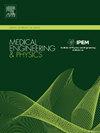Phase changes of the flow rate in the vertebral artery caused by debranching thoracic endovascular aortic repair: Effects of flow path and local vessel stiffness on vertebral arterial pulsation
IF 1.7
4区 医学
Q3 ENGINEERING, BIOMEDICAL
引用次数: 0
Abstract
Despite numerous studies on cerebral arterial blood flow, there has not yet been a comprehensive description of hemodynamics in patients undergoing debranching thoracic endovascular aortic repair (dTEVAR), a promising surgical option for aortic arch aneurysms. A phase delay of the flow rate in the left vertebral artery (LVA) in patients after dTEVAR compared to those before was experimentally observed, while the phase in the right vertebral artery (RVA) remained almost the same before and after surgery. Since this surgical intervention included stent graft implantation and extra-anatomical bypass, it was expected that the intracranial hemodynamic changes due to dTEVAR were coupled with fluid flow and pulse waves in cerebral arteries. To clarify this issue, a one-dimensional model (1D) was used to numerically investigate the relative contribution (i.e., local vessel stiffness and flow path changes) of the VA flow rate to the phase difference. The numerical results demonstrated a phase delay of flow rate in the LVA but not the RVA in postoperative patients undergoing dTEVAR relative to preoperative patients. The results further showed that the primary factor affecting the phase delay of the flow rate in the LVA after surgery compared to that before was the bypass, i.e., alteration of flow path, rather than stent grafting, i.e., the change in local vessel stiffness. The numerical results provide insights into hemodynamics in postoperative patients undergoing dTEVAR, as well as knowledge about therapeutic decisions.
胸椎血管内主动脉去分支修复引起椎动脉流速的相位变化:血流路径和局部血管刚度对椎动脉脉动的影响
尽管有大量关于脑动脉血流的研究,但尚未有关于行去分支胸椎血管内主动脉修复术(debranch thoracic endovascular aortic repair, dTEVAR)患者血流动力学的全面描述,dTEVAR是治疗主动脉弓动脉瘤的一种很有前景的手术选择。实验观察到dTEVAR术后患者左椎动脉(LVA)流速与术前相比有相延迟,而右椎动脉(RVA)流速在术前和术后基本保持不变。由于该手术干预包括支架植入和解剖外搭桥,因此我们期望dTEVAR引起的颅内血流动力学变化与脑动脉的流体流动和脉搏波相结合。为了澄清这一问题,我们使用一维模型(1D)来数值研究VA流量对相位差的相对贡献(即局部血管刚度和流道变化)。数值结果表明,相对于术前患者,dTEVAR术后患者的LVA流速有相位延迟,而RVA流速无相位延迟。结果进一步表明,影响手术后LVA流速相对于术前相位延迟的主要因素是搭桥,即流动路径的改变,而不是支架植入术,即局部血管刚度的改变。数值结果提供了对dTEVAR术后患者血流动力学的见解,以及关于治疗决策的知识。
本文章由计算机程序翻译,如有差异,请以英文原文为准。
求助全文
约1分钟内获得全文
求助全文
来源期刊

Medical Engineering & Physics
工程技术-工程:生物医学
CiteScore
4.30
自引率
4.50%
发文量
172
审稿时长
3.0 months
期刊介绍:
Medical Engineering & Physics provides a forum for the publication of the latest developments in biomedical engineering, and reflects the essential multidisciplinary nature of the subject. The journal publishes in-depth critical reviews, scientific papers and technical notes. Our focus encompasses the application of the basic principles of physics and engineering to the development of medical devices and technology, with the ultimate aim of producing improvements in the quality of health care.Topics covered include biomechanics, biomaterials, mechanobiology, rehabilitation engineering, biomedical signal processing and medical device development. Medical Engineering & Physics aims to keep both engineers and clinicians abreast of the latest applications of technology to health care.
 求助内容:
求助内容: 应助结果提醒方式:
应助结果提醒方式:


